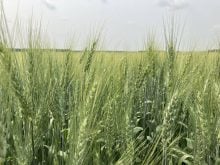Canola growers haven’t planted this year’s crop yet, but they might already want to be thinking about when they’ll be taking it off.
Canola Council of Canada agronomist Jim Bessel said a 2009 survey found that only half of producers correctly rely on seed colour change to determine when to swath.
Twenty-four percent look at pod colour change.
“They may drive by the crop and rely on that,” he said, but that is the wrong way to assess crop maturity.
Read Also

Volatile temperatures expected for this winter
DTN is forecasting a lot of temperature variability in the Canadian Prairies this winter. Precipitation should be close to average.
Getting into the crop and opening the pods is critical.
“The pod can be fairly green and you open it up and the seed is well on its way,” Bessel said.
Or, it can be the other way around.
He said changes in canola genetics mean producers can’t rely on a cursory look at the field. A better assessment of maturity would lead to higher yields, weights and oil content.
“We would certainly like to see (the percentage) improve,” he said. “There is a cost benefit as far as effort and time.”
The telephone survey of more than 1,000 prairie producers asked farmers about several agronomic practices. Bessel released some of the information at a soil conservation meeting in Regina last month.
He said 85 percent of respondents are basing combining decisions on moisture content and green seed count, as they should.
“A little more than 14 percent are straight combining,” he said. “A little over 13 percent are wanting to straight combine.”
He said the practice is gaining popularity because farms are getting larger and fewer producers have the time to harvest more acres. The survey found the average farm size of respondents to be 2,967 acres.
Eliminating the need to buy and operate a swather can also save money.
However, Bessel said the final decision must be made yearly.
“Every year is different,” he said. “There’s no silver bullet here, at least we’re not aware of it at this point.”
The practice was started by growers who successfully straight combined mustard and thought the close relationship between the two crops meant they could do the same for canola.
Bessel said rapa varieties seem to do fairly well, but napus varieties have always been a problem.
He said straight combining may become more effective as the number of canola hybrids increases.
However, the weather and the number of plants per sq. metre will always be factors.
A crop that is well-knitted with a slight lean has a better chance of withstanding straight combining. Individual plants won’t move as much, and less shattering should occur.
Bessel said humidity is also a factor. A crop that is bone dry will obviously shatter more easily.
Albertans have adopted straight combining more than their Saskatchewan counterparts, he said.
Bessel also said producers must be aware of how their combines are set and how much seed they lose out the back.
“You cannot have good agronomic practices unless you have good equipment to accomplish that,” he said.
The concept is the same as when farmers had to set their threshing machines.
Bessel is working with the Prairie Agricultural Machinery Institute to re-establish combine clinics so that producers know exactly how to set tolerances and gauges for maximum profitability and performance.
“When combining, with all the new technology we have in those cabs and how that relates to harvesting, (performance) should be enhanced,” he said.
Seed thrown out the back of the combine is more than an immediate economic loss. It also results in costs to control volunteers.
Bessel said the size and horsepower of today’s equipment allows farmers to push an incredible amount of biomass through a combine, which means the separating system needs to be working its best.
“The more we can capture, the better we are at sustaining ourselves,” he said.
A producer who loses five bushels per acre behind the combine on 160 acres is losing 800 bu. At $8 per bu., that’s a $6,400 loss.
Put another way, a producer might be expecting a 40 bu. per acre crop. Natural and processing losses could lead to a not-unreasonable overall loss of five percent, which is two bu. per acre or $2,560 at $8 per bu. on a quarter section.















